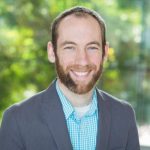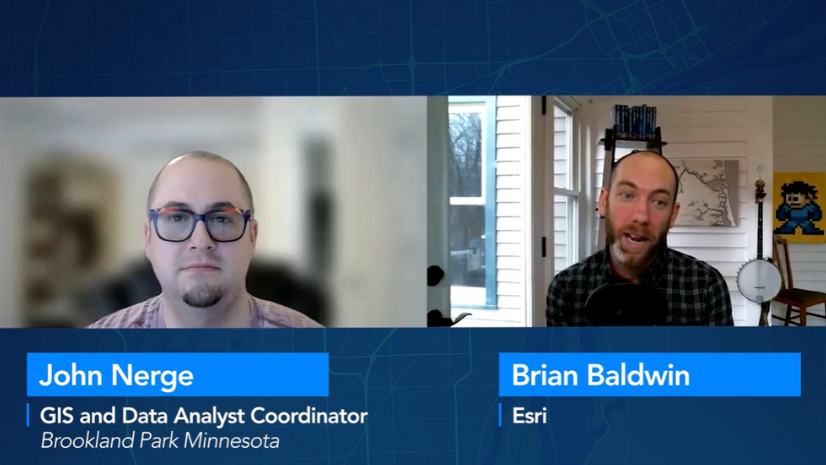It might be obvious, but you should look for work in a field that you enjoy and care about. Abigail Krump works as a conservation geographic information system (GIS) analyst for Blue Raster, and in the short conversation we had recently, it was clear how passionate and excited she is about her work. Krump offered great insights for those looking to get into the GIS field, but more than anything else during our conversation, the remarks she made about not following the current trends but, instead, following your passions were especially meaningful for me.
Watch this short, five-minute interview with Krump, or read the following transcript.
Video Transcript
Brian Baldwin
I’m Brian Baldwin, a lead solution engineer with Esri. I’m really thrilled today to be joined by Abigail Krump, who works as a conservation GIS analyst for Blue Raster. I wanted to have a conversation with Abigail to talk about what she has seen in the world of GIS and some of her experiences and, really, to help students and faculty understand what the needs are out in the field today [by hearing] from those that are working in the field. So, first, Abigail, would you mind going through who you are and what you do in your role at Blue Raster?
Abigail Krump
Yeah, absolutely. I’m a conservation GIS analyst, which means predominantly at Blue Raster I work with a lot of conservation nongovernmental organizations [NGOs], whether that be the Jane Goodall Institute, The Nature Conservancy, or the World Resource Institute. Those are some of our largest—some of my largest clients. I’m also a self-taught Python developer, Python GIS developer—and I also say, “learning to be,” and it’s a continuous process. So, I spend a lot of time building automated tools and workflows that allow these NGOs to make better sustainable decisions.
Brian Baldwin
Oh, that’s awesome. I think so many students, especially now, are—a passion for them is to make an impact and make this broader change in the world. So the fact that you’re able to work with these amazing nonprofits—that’s probably a fun, rewarding part of the job.
Abigail Krump
It’s rather mind-blowing to be working with these incredible nonprofits that you grow up hearing about. In terms of impact, it is so fascinating because a lot of them have the same idea of how they want to use GIS to make an impact. I think in the world now, we’re transitioning from, “OK, let’s create a map and let’s create a choropleth to hand off as a report.” All of it needs to be dynamic. I’m seeing it across the board, whether Nature Conservancy is doing this; Jane Goodall Institute is doing this; where it’s decision support systems; where it’s these dynamic, live datasets that are being shown to USAID [United States Agency for International Development] for funding or shown to policy makers for decisions on regular feedback. It’s all about the [question], How can we dynamically interact with this data to make those decisions?
Brian Baldwin
I love that. And I think something I’ve tried to have conversations with people a lot about is moving from those static representations of data or maps or visualization and moving towards exactly what you said—a way that you can share dynamic content and things in just a much more compelling way. I guess that leads me into the next question for you. Not to put your program on the spot, but did you feel like your degree program or some of your courses got you ready for what you are doing in GIS today?
Abigail Krump
Absolutely, just not in a traditional sense. So, my degree is in ecology, and I took two courses in GIS, so not a whole lot of foundational learning happened at the university within GIS. But my degree in ecology, specifically in my role now, is absolutely useful for making sure I’m having the correct conversations with my clients. I already understand they’re stakeholders. I understand the science behind what they’re trying to achieve. So we can skip a lot of the explanation of why we are running certain analyses and who needs to be involved. Additionally, I think I look for the same level of passion. I came from a nonprofit to Blue Raster, and I think coming with that nonprofit passion [for] conservation and for the work that they are doing is extremely valuable. And I think they see it as, I’m authentic about my love for chimpanzees as much as my clients are. And so that—and then in terms of technical skills, I think my degree in hard science and getting a bachelor’s in ecology is debugging-wise, I always think about the scientific method. My supervisor says this all [the] time, that I approach everything with, “All right, what’s the control variable here? We’re having this issue, so let’s knock out the different variables that could be happening.” So again, not a supertraditional path, but it definitely has allowed me to grow into the career that I wanted it to be.
Brian Baldwin
I love that. And you mentioned just two courses in GIS, and so it was just that limited background—but I know, on the side too, you’re continually trying to learn to push yourself. And like you said with Python, it’s a lot of that learning on the side. Any tips there for learners? And I know you have gone through this a thousand times, but what would you say for those who are looking to get into this field? Is there any specific advice or area you would tell people to dive into?
Abigail Krump
I’ve tried to make sure that people are following the path of [whatever] they are most passionate about. I think that Python and automation and machine learning and AI are hot topics right now, but I think the field is putting pressure on young professionals to immediately go that direction. I want to make it known to people entering the field, that’s not all the field is. We still need people that are interested in doing configurable applications. We still need people that do design and know how to make good, solid maps. I think about some of my colleagues who don’t touch Python or touch coding at all. I could not do half of what they do. I’m so trying to make sure that you actually follow the route that you enjoy and not just the route you think that is trending, because the fundamentals of the field will always remain the same. I fell into Python, and you don’t always need to fall into Python. I’m the weird person that’s, like, on a beach with my textbook, highlighter, and a pen. I’m not saying you have to go that far, but follow whichever way that’s best for you.
Brian Baldwin
I really like that. I mean, I think a lot of times—and maybe it’s just that limited exposure to what the roles are and what jobs can be—but it’s thinking, “I need to be a programmer. I need to be somebody. . . .” And you mentioned some of the [buzzwords]. If it’s AI or machine learning, everybody doesn’t need to become an expert in those things. There’s room for your skill and your passion in a lot of these places.
Abigail Krump
For sure—also, finding a way, finding a field that GIS applies to that you enjoy learning about and thinking about. We’re all doing similar things in terms of the method, but you’re thinking about the data eight hours a day. You might want to like what you’re doing, thinking about.
Brian Baldwin
That’s a great point. Well, Abigail, I just want to say thank you so much. I really appreciate you taking the time to have this quick conversation. I think it’s a lot of great insight for students and faculty to take into how GIS [has] changed and where this field’s going.
Abigail Krump
Of course, and thank you so much, Brian.
To learn more about Modern GIS, visit this webpage with lessons, resources, and stories from other industry professionals and faculty.




